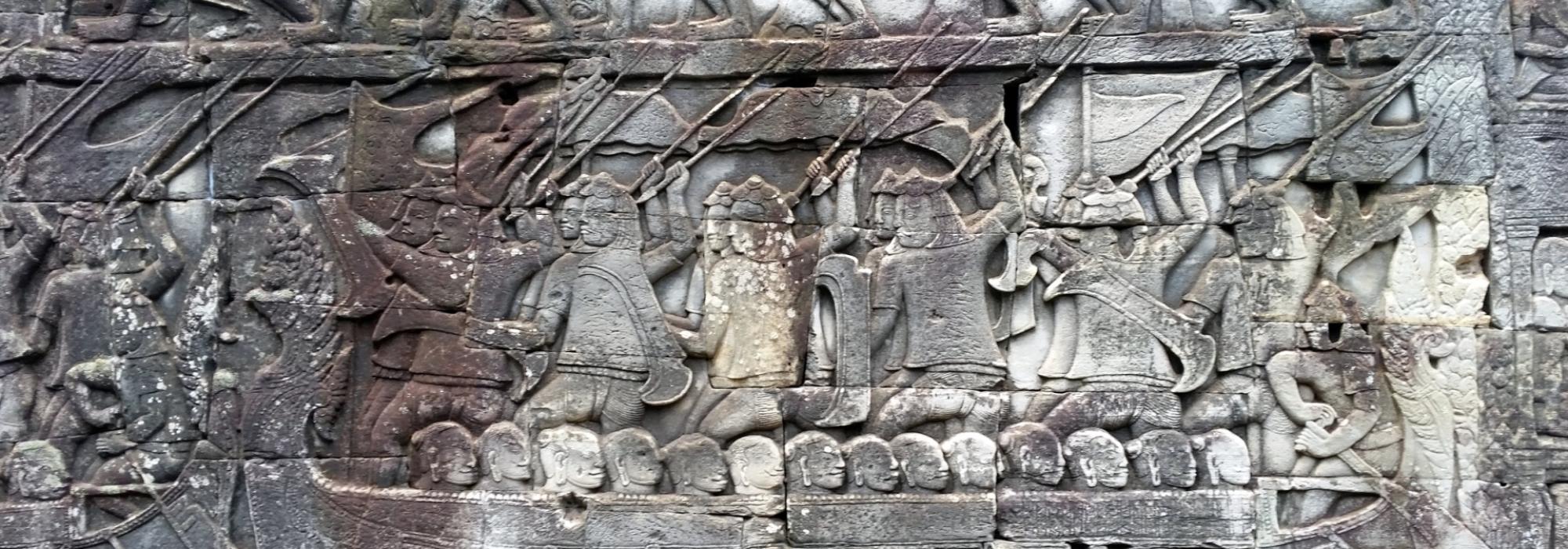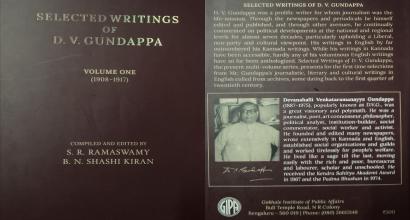For a person who has lived in the Indian main land and has experienced sanatanic lifestyle to the fullest, a mere visit to the Cambodian monuments will convince beyond doubt, the connection this far off settlement must have had with India. It is also evident through the sculptures found in the country that the roots of both the form and the content lie in India. Thus, a few pointers and examples will suffice to reaffirm the thesis.
In the concluding words of his work “Kambuja Desha”, RC Majumdar points out the following
“If art is an expression of national character and a fair index of the culture and civilization of a people, Kambuja easily takes the leading position among the Indian colonies in Indo-China and constitutes an immortal landmark and the greatest living testimony to the splendour of the civilization of which it was a product. …. The Kambuja architecture followed a regular course of development from the purely Indian type with which it started. It underwent a process of evolution such as we notice in different parts of India itself, in different ages, …..local genius and environments added new conceptions of beauty and principles of construction……And this is only what we could expect in a living society. It is to be noted that the Indian colonization in the Far East was not an imperialism in any form, political or economic. It transfused new blood, in the shape of the cultural heritage of India to create new life and spirit on alien soils. It transformed the weaker and the more backward by fresh vitality and so long as this life-giving force was there, the people were quickened by new impulses and did not merely imitate but developed healthy lives of their own on the foundations well and truly laid by the Indians.” - RC Majumdar
Three points are noteworthy in the observations made by RC Majumdar
- “Cambodia is the greatest living testimony to the splendour of the civilization of which it was a product”
- “It (Art and architecture in Cambodia) underwent a process of evolution such as we notice in different parts of India itself, in different ages; the people did not merely imitate but developed healthy lives of their own on the foundations well and truly laid by the Indians” -> This is what is expected of a living society. It does not stagnate and is dynamic. Producing new forms of art and creative interpolation of ideas borrowed from the motherland is the sign of a democratic society, where there is freedom of expression and growth.
- “It is to be noted that the Indian colonization in the Far East was not an imperialism in any form, political or economic” – It was a cultural expansion and would fall under the category of dharma-vijaya (and not artha-vijaya, lobha-vijaya or asura-vijaya)
[As an aside, these can be contrasted with the countries where the predatory religions took their birth and where they spread]
Art of Cambodia
 Sandstone Sculpture of Vishnu found at Tuol Dai Buon, dating from 6-7th Century CE. Currently at the National Museum, Phnom Pen, Cambodia
Sandstone Sculpture of Vishnu found at Tuol Dai Buon, dating from 6-7th Century CE. Currently at the National Museum, Phnom Pen, Cambodia
The monuments and sculptures of Cambodia broadly fall into two divisions, namely the primitive and the classic. The classical age is associated with the rise of Angkor and dates from about the 10th Century CE. The primitive art flourished from about the 7th century CE and is seen continued by the Cambodian rulers until the 7th Century CE (Majumdar 1943: 42). The art of the primitive period has close affinity with the Gupta Art and most scholars converge in their view that it is derived from India. It is irrefutable that the art of Fu-nan was purely Indian. In the later days, however, with the amalgamation of the local traditions a different style evolved in the 9th and 10th Century CE. Through Fu-nan, the Indian Art of the Gupta age spread over a wide territory in India-China along with other phases of Indian culture (Majumdar, 1943: 43).
Art of Fu-nan (pre-Angkor period)
Fu-nan was one of the earliest known kingdoms of Cambodia, mythically founded by a brāhmaṇa named Kauṇḍinya from India through his marriage with a Naga princess. The kingdom settled along the banks of the river Mekong, which flows through today’s Laos, Thailand, Cambodia and Vietnam. [Some guess that it was a reconstruction of the river Ganga of India in the newly founded territories. Mekong is a corrupt form of Mā Ganga, is a possibility. It also means “mother of water” in today’s Thai language, indicating their traditional personification of rivers and association of emotion and divinity to nature]. The first sculptures of the Indian deities including the Buddhist ones date back to this period.
 Hari-Hara - 7th Century CE - Found at Prasat Phnom Da, Currently at the Musee Guimet, Paris
Hari-Hara - 7th Century CE - Found at Prasat Phnom Da, Currently at the Musee Guimet, Paris
The sculpture on the top-right is a typical specimen of the pre-Angkor period. It represents Vishnu with four hands and is sculpted in sandstone (about 72 inches tall). The technique used is primitive as is evident from the residual stone present to support the image (below the two hands and between the legs). The discus (cakra) is attached to the head as well. There is a slight uudvāhita-kaṭi on the left (raised hip). The discus is held either in the kartharī or the kaṭakāmukha-hasta. There was probably a lotus or a conch in the right hand. One can also notice three lines in the neck (tivaḻī) and the deity stands relaxed.
 The deity in the head of the figure is identified as Avalokiteshvara or Padmapani (650-700 CE), currently in Musee Guimet, Paris
The deity in the head of the figure is identified as Avalokiteshvara or Padmapani (650-700 CE), currently in Musee Guimet, Paris
The image on the left shows one of the early depictions of Hari Hara found at Phnom Da, the ancient capital of the Fu-nan kingdom. The sculpture clearly depicts the matted locks of hair of Hara on the right half of the body, complete with a crescent moon at the top and Hari's crown on the left. The ear ornament is different on both the sides too. The right side has a vertical half-eye, to act as the third eye of Shiva. As discussed in the previous part of this series, Hari-hara was a deity commonly worshiped in ancient Cambodia.
 Ganesha was a prominent deity during the Khmer period, before the foundation of the Angkor. (Sandstone, 6th-7th Century)
Ganesha was a prominent deity during the Khmer period, before the foundation of the Angkor. (Sandstone, 6th-7th Century)
The image on the left shows a Ganesha and the one on the right shows Avalokiteshvara from this period. It is interesting to note that throughout South East Asia, Ganesha is predominantly worshiped, particularly as the head of Yakshas (Yaksha-raja). Even today, every Hindu house in the island of Bali (Indonesia) has a Ganesha at the threshold.
 Entrance to a house in Bali, Indonesia
Entrance to a house in Bali, Indonesia
The Angkor Period
(Classic Khmer Period)
The classic Khmer period extended from the early 9th century CE to the mid 14th Century CE, i.e., between the ascension of Jayavarman II (802 CE) to the death of Shrindrajayavarman. Hindusism and Buddhism were practised predominently. Most of the monuments of this period were built out of sandstone or laterite. It was in this era that the biggest Hindu temple complex till date, the Angkor Wat was built by Suryavarman II and Jayavarman VII in teh 12th Century CE.
Three aspects are worth noting in the sculptures found in this period -
- There is frequent reference to the Samudra-mathana (Churning of the ocean for Amrita - elixir of life). Most of the temple entrances on either side have rakshasas and devas pulling the gain snake - Vasuki. Additionally, the Angkor Wat itself, in a sense, is imagined as the Meru and is being churned by positive and negative forces.
- Nagas are prominently depicted in most places and the Naga cult was prominent in the kingdom
- The sculptures in the Angkor Wat complex consist of several daily life images. These contain several images of ships, sea, sea animals and sea voyage.
 Boat in sculpture - Aihole
Boat in sculpture - Aihole
It is noteworthy that ships are hardly found in temple sculpture in mainland India. One of the depictions of a boat is found in the Durga temple at Aihole, Karnataka (dated to about 6th Century CE). However, it is merely pictures the crossing of the Sarayu river by Rama and Seeta, ferried by Guha.
 Ships. Sea animals - Sculpture from Angkor Wat temple complex
Ships. Sea animals - Sculpture from Angkor Wat temple complex
It is not unlikely that the excessive importance given to snakes, boats and the samudra-mathana episode is because of the cultural memory of the Cambodians' roots in India. The early settlers would have traveled to the new land by sea from India. Additionally, Shatavadhani Dr. R Ganesh, a renowned poet and scholar of India opines that the first major battle in the mainland India was between the Devas and Asuras, which is mythological and metaphorically depicted in the legend of the Samudra-mathana. It is likely that, the losers in the battle, the 'Asuras' (i.e., the 'Rakshasas') migrated out of India and the winners kept the mainland of India. This was followed by two other major wars - the Dāśarājña and the Kurukṣetra. Thus, the first migrants from India settled outside its early frontiers, which we now identify as the South East Asian countries (This includes Sri Lanka. People of the country, even today, identify themselves with the Rakshasa clan. The author has comprehended this through his interaction with Sri Lankans in the country, including their High Commission Officer in India). Here, 'Rakshasa' merely refers to a clan and not necessarily a stereotyped (usually negative) characteristics.








































